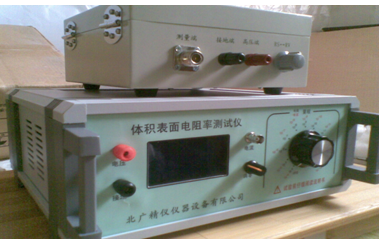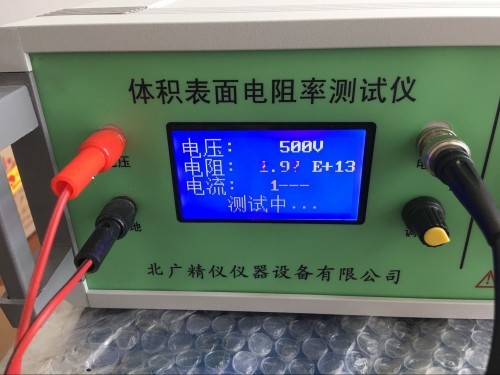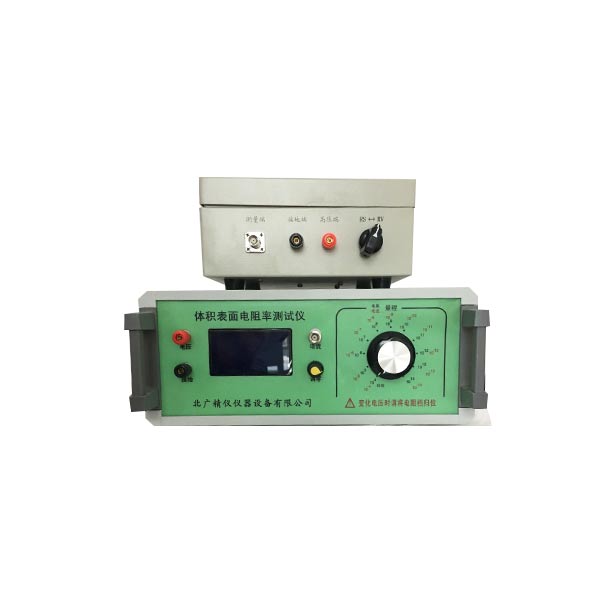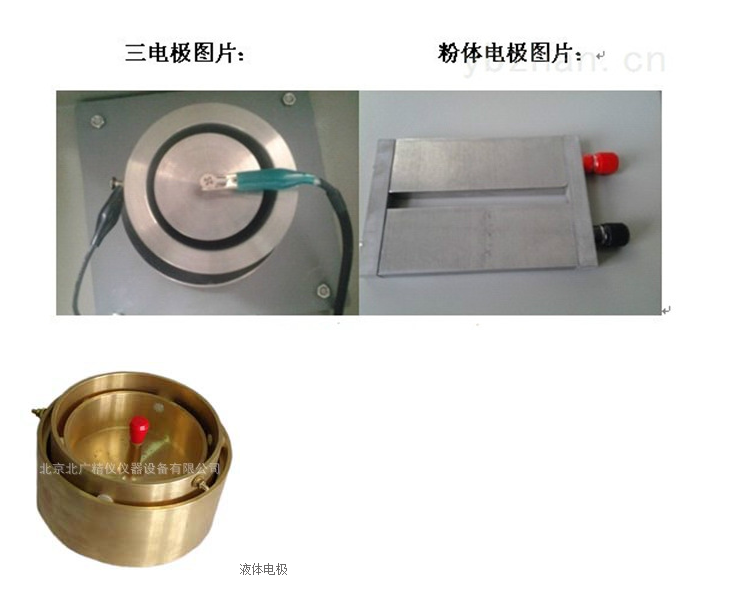
直流表面电阻率测试仪 表面电阻率surface resistivity
在绝缘材料的表面层里的直流电场强度与线电流密度之商,即单位面积内的表面电阻。面积的大
小是不重要的。
注:表 面 电 阻 率 的S1单 位 是Q。实 际 上 有 时 也 用“欧 每 平 方 单 位”来 表 示 。
直流表面电阻率测试仪 测试
测量时从低档位逐渐拔往高档,每拨一次稍停留1~2秒以使观察显示数字, 当被测电阻大于仪器测量量程时,电阻表显示“1”,此时应继续将仪器拨到量程更高的位置,当测量仪器有显示值时应停下,当前的数字乘以档次即是被测电阻值。当有显示数字时不要再往更高次档拨,否测仪器会过量程,机内保护电路开始工作,仪器测量准确度会下降。
标准配置:
1、测试仪器 1台
2、.电源线 1条
3、测试电极 1套
4、使用说明书 1份
5、测试主机 1台
6、出厂测试报告 1份
7、上位机连接线 1条
8、屏蔽箱 1个
9、测试夹 1套
10、232数据串口组件1套
应用
电阻率较低的物质被称为导体,常见导体主要为金属,而自然界中导电性佳的是银,其次为半导体,硅锗。当存在外电场时,金属的自由电子在运动中不断和晶格节点上做热振子的正离子相碰撞,使电子运动受到阻碍,因而就具有了一定的电阻。其他不易导电的物质如玻璃、橡胶等,电阻率较高,一般称为绝缘体。介于导体和绝缘体之间的物质(如硅)则称半导体。电阻率的科学符号为 ρ(Rho)。 已知物体的电阻,可由电阻率ρ、长度l与截面面积A计算:ρ=RA/I,在该式中, 电阻R单位为欧姆,长度l单位为米,截面面积A单位为平方米,电阻率 ρ单位为欧姆?米
工作原理
根据欧姆定律,被测电阻Rx等于施加电压V除以通过的电流I。传统的高阻计的工作原理是测量电压V固定,通过测量流过取样电阻的电流I来得到电阻值。从欧姆定律可以看出,由于电流I是与电阻成反比,而不是成正比,所以电阻的显示值是非线性的,即电阻无穷大时,电流为零,即表头的零位处是∞,其附近的刻度非常密,分辨率很低。整个刻度是非线性的。又由于测量不同的电阻时,其电压V也会有些变化,所以普通的高阻计是精度差、分辨率低。
本仪器是同时测出电阻两端的电压V和流过电阻的电流I,通过内部的大规模集成电路完成电压除以电流的计算,然后把所得到的结果经过A/D转换后以数字显示出电阻值,即便是电阻两端的电压V和流过电阻的电流I是同时变化,其显示的电阻值不象普通高阻计那样因被测电压V的变化或电流I的变化而变,所以,即使测量电压、被测量电阻、电源电压等发生变化对其结果影响不大,其测量精度很高,从理论上讲其误差可以做到零,而实际误差可以做到千分之几或万分之几。
电阻的作用:
电阻在电路中的作用:利用著名的欧姆定律可以利用电阻控制电路中的电压、电流。
电阻的主要物理特征就是可以变电能为热能,因此热水器中的发热元件、电灯泡、电烫斗就是利用了电阻的作用制成的。另外电阻有怕热的特性,当导体材料温度升高时材料的电阻率会增大(有些材料则表现为减小),因此利用电阻的这种特性可以制作温度测量计(不知道你看见过没,插一根“铁丝”就能测量温度的方法就是利用了这种电阻材料作用的)。
另外一些材料的电阻还会受到光线照射的印象,而利用这样的材料可以制成光敏电阻,利用这点作用可以方便的设计光控电路以及光的测量和光电转换等领域。
技术指标
1、电阻测量范围:1?104Ω~1?1018Ω。
2、电流测量范围为:2?10-4A~1?10-16A
3、双表头显示:3.1/2位LED显示
4、内置测试电压:10V、50V、100V、250、500、1000V
5、基本准确度:1% (*注)
6、使用环境: 温度:0℃~40℃,相对湿度<80%
7、机内测试电压:10/50/100/250/500/1000V任意切换
8、供电形式:AC 220V,50HZ,功耗约5W
9、仪器尺寸:285mm? 245mm? 120 mm
10、质量: 约2.5KG
范围:
1本试验方法包含直流绝缘电阻,体积电阻和表面电阻的测量所用直流程序。通过该测量及样本和电极的几何尺寸,可以计算出电绝缘材料的体积电阻和表面电阻,同时还可以计算出相应的电导和电导率。
2这些试验方法不适用于测量中等导电材料的电阻/电导。这些材料评估可采用试验方法D4496。
3本标准描述了几种可选择的测量电阻(或电导)的普通备用方法。特殊材料科采用合适的标准ASTM试验方法进行测试,这些特殊材料具有电压应力范围和有限起电时间,同时规定了样本结构和电极几何形状。这些个别特殊试验方法将能更好得定义测量值的精度和偏差。
4本标准并没有完全列举所有的安全声明,如果有必要,根据实际使用情况进行斟酌。使用本规范前,使用者有责任制定符合安全和健康要求的条例和规范,并明确该规范的使用范围。
主要应用范围
材料高阻测试测量如防静电产品(防静电鞋、防静电塑料橡胶制品、计算机房防静电活动地板等)电阻值的检测;
材料体电阻(率)和表面电阻(率)测量;
电化学和材料测试,以及物理,光学和材料研究;
微弱电流测量如光电效应和器件暗电流测量。
电阻的作用:
电阻在电路中的作用:利用著名的欧姆定律可以利用电阻控制电路中的电压、电流。
电阻的主要物理特征就是可以变电能为热能,因此热水器中的发热元件、电灯泡、电烫斗就是利用了电阻的作用制成的。另外电阻有怕热的特性,当导体材料温度升高时材料的电阻率会增大(有些材料则表现为减小),因此利用电阻的这种特性可以制作温度测量计(不知道你看见过没,插一根“铁丝”就能测量温度的方法就是利用了这种电阻材料作用的)。
另外一些材料的电阻还会受到光线照射的印象,而利用这样的材料可以制成光敏电阻,利用这点作用可以方便的设计光控电路以及光的测量和光电转换等领域。
测试步骤:
1、测试温度23?2℃,相对湿度65?5%,无外界电磁场干扰环境中进行。
2、测试时对试样所加电压为100V~500V的直流电压,选择电压档次。
3、将试样倒入高压电极内,使液面刚好和环电极下缘全部接触为止。
4、将充分放电后的试样和电极,按固体(液体)体积及表面电阻率测试仪要求接线。
外电极(高压电极)接高固体(液体)体积及表面电阻率测试仪的高压输出端。
内电极(测量电极)接固体(液体)体积及表面电阻率测试仪的测量端。
中电极(环电极)接固体(液体)体积及表面电阻率测试仪的接地端。
5、仪器预热30分钟,稳定后调整仪器(调零),加上试验1分钟,读取电阻指示值,然后放电1分钟,再测试一次,以二次的算术平均值作为试验样品电阻指示值。
电极electrodes
电极是具有一定形状、尺寸和结构的与被测试样相接触的导体。
注:绝缘电阻是加在与试样相接触的两电极之间的直流电压与通过两电极的总电流之商 绝缘电阻取决于试样的表面电阻和体积电阻(见GB/T 10064-2006)
符合标准:
GB/T 1410-2006《 固体绝缘材料体积电阻率和表面电阻率试验方法》
ASTM D257-99《绝缘材料的直流电阻或电导试验方法》
GB/T 10581-2006《绝缘材料在高温下电阻和电阻率的试验方法》
GB/T 1692-2008《硫化橡胶 绝缘电阻率的测定》
GB/T 2439-2001《硫化橡胶或热塑性橡胶 导电性能和耗散性能电阻率的测定》
GB/T 12703.4-2010《纺织品 静电性能的评定 第4部分:电阻率》
GB/T 10064-2006_《测定固体绝缘材料绝缘电阻的试验方法》
重要性和用途:
1绝缘材料用于电子系统彼此和与地面之间隔离,该材料能提供零部件的机械支撑。由于此用途,通常要求具有尽可能高的绝缘电阻,以与可接受的机械、化学和耐热性能一致。因为绝缘电阻或电导组合了体积和表面电阻或电导,当实际使用时,要求试验样本和电极具有相同的形式,此时的测量值是非常有用的。表面电阻或电导随着湿度发生快速变化,然而体积电阻或电导则稍微变化,尽管总的变化在一些变化可能更大。
2电阻或电导可用于间接预测某些材料的低频率电介质击穿和损耗因数性能。电阻或电导通常作为湿度含量,固化程度,机械连续性或不同类型老化的间接测量方式。这些间接测量的效用取决于通过理论或经验研究确立的相关度。表面电阻的降低可导致因为电场强度降低而发生电介质击穿电压的增加,或者由于应力面积的增加而发生电介质击穿电压的降低。
3所有的电介质电阻或电导都取决于电化时间长短和施加的电压值(除了普通的环境变量之外)。这些因素必须已知,同时报告,以使得电阻或电导测量值有意义。在电绝缘材料工业中,形容词“表观”通常适用于在任意选择电化时间条件下获得的电阻值。见X1.4。
4体积电阻或电导可通过在特定应用场合设计某个绝缘体使用的电阻和尺寸数据计算得出。研究已经表明电阻或电导随着温度和湿度的变化而变化(1,2,3,4)4,同时在设计工作条件时,必须已知这种变化。体积电阻或电导测量值通常用于检查绝缘材料的均匀性,或者对于加工,可探测影响材料质量的导电杂质,而这不容易通过其它方法观察到。
5体积电阻超过1021Ω?cm(1019Ω?cm)时,样本在普通实验室条件测试获得的数值计算得出体积电阻,如果结果确实可疑,则应考虑通常使用的测量设备的局限性。
6表面电阻或电导不能精确测量,只能近似测量,因为体积电阻或电导总是受到测量方法的影响。测量值还受到表面污染的影响。表面污染及其积聚速度受到许多因素的影响,包括静电充电和界面张力。这些因素反过来可以影响表面电阻。当包括污染,但是在通常常识下判断不是电绝缘材料的材料性能时,此时表面电阻或电导可视为与材料性能相关。
Compliant with standards:
GB/T 1410-2006 "Test Method for Volume and Surface resistivity of Solid Insulation Materials"
ASTM D257-99 "Test Method for DC Resistance or Conductivity of Insulation Materials"
GB/T 10581-2006 "Test method for resistance and resistivity of insulating materials at high temperatures"
GB/T 1692-2008 "Determination of Insulation Resistance of Vulcanized Rubber"
GB/T 2439-2001 "Determination of Electrical Conductivity and Dissipation Properties of Vulcanized Rubber or Thermoplastic Rubber"
GB/T 12703.4-2010 "Evaluation of electrostatic properties of textiles - Part 4: Electrical resistivity"
GB/T 10064-2006_ "Test Method for Determining Insulation Resistance of Solid Insulation Materials"
Importance and purpose:
1. Insulation material is used to isolate electronic systems from each other and from the ground, providing mechanical support for components. Due to this purpose, it is usually required to have the highest possible insulation resistance to be consistent with acceptable mechanical, chemical, and heat resistance performance. Because insulation resistance or conductivity combines volume and surface resistance or conductivity, when in actual use, it is required that the test sample and electrode have the same form, and the measured values at this time are very useful. Surface resistance or conductivity changes rapidly with humidity, while volume resistance or conductivity changes slightly, although the overall change may be greater in some cases.
Resistance or conductivity can be used to indirectly predict the low-frequency dielectric breakdown and loss factor performance of certain materials. Resistance or conductivity is usually used as an indirect measurement method for humidity content, curing degree, mechanical continuity, or different types of aging. The utility of these indirect measurements depends on the correlation established through theoretical or empirical research. The decrease in surface resistance can lead to an increase in dielectric breakdown voltage due to a decrease in electric field strength, or a decrease in dielectric breakdown voltage due to an increase in stress area.
All dielectric resistances or conductivities depend on the duration of electrification and the applied voltage value (except for common environmental variables). These factors must be known and reported simultaneously to make the resistance or conductivity measurements meaningful. In the electrical insulation material industry, the adjective "apparent" is usually applied to the resistance value obtained under any chosen electrochemical time conditions. See X1.4.
The volume resistance or conductivity can be calculated by designing the resistance and size data of an insulator for specific applications. Research has shown that resistance or conductivity varies with temperature and humidity (1,2,3,4), and this variation must be known when designing operating conditions. Volume resistance or conductivity measurements are commonly used to check the uniformity of insulation materials, or for processing, to detect conductive impurities that affect material quality, which are not easily observed through other methods.
When the volume resistance exceeds 1021 Ω? cm (1019 Ω? cm), the sample's volume resistance is calculated based on the values obtained from testing under normal laboratory conditions. If the results are indeed suspicious, the limitations of commonly used measuring equipment should be considered.
Surface resistance or conductivity cannot be accurately measured and can only be approximately measured, as volume resistance or conductivity is always affected by the measurement method. The measured values are also affected by surface contamination. Surface pollution and its accumulation rate are influenced by many factors, including electrostatic charging and interfacial tension. These factors can in turn affect surface resistance. When pollution is included, but it is common sense to judge that the material properties are not electrical insulation materials, surface resistance or conductivity can be considered related to the material properties.
Surface resistivity
The quotient of the direct current electric field strength and the line current density in the surface layer of insulating materials, which is the surface resistance per unit area. Large area
Small is not important.
Note: The unit of S1 for surface resistivity is Q. In fact, sometimes it is also expressed as' Euro per square unit '.
test
When measuring, gradually shift from low gear to high gear, pause for 1-2 seconds each time to observe the displayed number. When the measured resistance is greater than the measuring range of the instrument, the resistance meter displays "1". At this time, continue to move the instrument to a higher range position. When the measuring instrument displays a value, stop. The current number multiplied by the level is the measured resistance value. When there are displayed numbers, do not dial higher gears, otherwise the measuring instrument will exceed the range, the internal protection circuit will start working, and the measurement accuracy of the instrument will decrease.
Standard configuration:
1. 1 testing instrument
2. 1 power cord
3. Test electrode 1 set
4. 1 copy of user manual
5. Test host 1 unit
6. 1 copy of factory test report
7. 1 upper computer connection cable
8. 1 shielding box
9. Test clip 1 set
10. One set of 232 data serial port components
application
Substances with low electrical resistivity are called conductors, and common conductors are mainly metals. In nature, silver has good conductivity, followed by semiconductors such as silicon and germanium. When there is an external electric field, the free electrons of the metal constantly collide with the positive ions of the lattice nodes that act as thermal oscillators, hindering the movement of electrons and thus possessing a certain resistance. Other materials that are not easily conductive, such as glass, rubber, etc., have high electrical resistivity and are generally referred to as insulators. The substance between a conductor and an insulator, such as silicon, is called a semiconductor. The scientific symbol for resistivity is ρ (Rho). Given the resistance of an object, it can be calculated from the resistivity ρ, length l, and cross-sectional area A ρ=RA/I,In this equation, the unit of resistance R is ohms, the unit of length l is meters, the unit of cross-sectional area A is square meters, and the unit of resistivity ρ is ohm meters
Working principle
According to Ohm's Law, the measured resistance Rx is equal to the applied voltage V divided by the current I passing through. The working principle of traditional high resistance meters is to measure a fixed voltage V and obtain the resistance value by measuring the current I flowing through the sampling resistor. From Ohm's Law, it can be seen that since the current I is inversely proportional to the resistance, rather than directly proportional, the displayed value of the resistance is nonlinear. That is, when the resistance is infinite, the current is zero, and the zero position of the meter head is ∞. The scales near it are very dense, and the resolution is very low. The entire scale is non-linear. Moreover, due to the variation in voltage V when measuring different resistances, ordinary high resistance meters have poor accuracy and low resolution.
This instrument simultaneously measures the voltage V across the resistor and the current I flowing through the resistor. The voltage divided by the current is calculated through an internal large-scale integrated circuit, and the obtained result is then converted into a digital display of the resistance value through A/D conversion. Even if the voltage V across the resistor and the current I flowing through the resistor change simultaneously, the displayed resistance value does not change due to changes in the measured voltage V or current I like a regular high resistance meter. Therefore, even if changes in the measured voltage, measured resistance, power supply voltage, etc. do not have a significant impact on its results, its measurement accuracy is very high. Theoretically, its error can be zero, while the actual error can reach a few thousandths or tens of thousands.
The function of resistance:
The role of resistance in circuits: Using the famous Ohm's law, resistance can be used to control the voltage and current in a circuit.
The main physical characteristic of resistance is that it can convert electrical energy into thermal energy, so the heating elements, light bulbs, and electric irons in water heaters are made using the effect of resistance. In addition, resistors have the characteristic of being sensitive to heat. When the temperature of the conductor material increases, the resistivity of the material will increase (some materials show a decrease). Therefore, using this characteristic of resistors can be used to make temperature measuring instruments (I don't know if you have seen it, the method of measuring temperature by inserting a "wire" is based on the effect of this resistor material).
In addition, the resistance of some materials can also be affected by light exposure, and using such materials can make photoresistors. This can facilitate the design of light control circuits, as well as the measurement and photoelectric conversion of light.
TECHNICAL INDEX
1. Resistance measurement range: 1 ? 104 Ω~1 ? 1018 Ω.
2. The current measurement range is: 2?10-4A~1?10-16A
3. Dual header display: 3.1/2 LED display
4. Built in test voltage: 10V, 50V, 100V, 250, 500, 1000V
5. Basic accuracy: 1% (* note)
6. Usage environment: Temperature: 0 ℃~40 ℃, relative humidity<80%
7. Internal test voltage: 10/50/100/250/500/1000V can be switched freely
8. Power supply form: AC 220V,50HZ,Power consumption is about 5W
9. Instrument size: 285mm ? 245mm ? 120mm
10. Quality: Approximately 2.5KG
体积表面电阻率测试仪是一种用于测量材料绝缘性能的精密仪器,广泛应用于多个行业,主要涉及对材料电绝缘性能有严格要求的领域。北京北广精仪仪器设备有限公司声场的体积表面电阻率测试仪主要用于以下主要适用行业及具体应用场景:
1. 电子与半导体行业
应用:测试PCB基板、绝缘薄膜、封装材料、半导体晶圆等的电阻率,确保其绝缘性能满足电子元件防短路、防漏电的要求。
案例:评估手机电路板在高湿度环境下的绝缘可靠性。
2. 电力与能源行业
应用:检测电缆绝缘层、变压器油、复合绝缘子等材料的电阻率,保障高压设备的安全运行。
案例:高压电缆出厂前的绝缘性能验证。
3. 航空航天与汽车制造
应用:评估飞机复合材料、汽车线束、电池隔膜等材料的电绝缘性,防止静电积聚或电磁干扰。
案例:新能源汽车电池组绝缘材料的质量控制。
4. 科研与新材料开发
应用:研究石墨烯、纳米涂层等新型材料的导电/绝缘特性,优化材料配方。
案例:柔性显示技术中透明导电薄膜的研发测试。
5. 医疗设备与生物材料
应用:检测医用塑料、导管、植入材料的绝缘性能,确保患者安全。
案例:心脏起搏器绝缘外壳的生物兼容性测试。
6. 塑料与橡胶工业
应用:质量控制环节中测量工程塑料、硅橡胶等材料的电阻率,用于防静电包装或绝缘部件生产。
案例:防静电托盘用于芯片运输前的电阻率达标测试。
6. 军事与国防
应用:评估隐身涂层、雷达吸波材料等的电学性能。
7 案例:军用无人机复合材料的电磁屏蔽效能测试。
8. 建材与家居行业
应用:检测地板、墙板的防静电性能(如数据中心地板)或绝缘性能(如电工套管)。
案例:洁净室防静电地板的验收测试。
9.能源存储(电池与电容器)
应用:测量隔膜、电解质的电阻率,优化锂电池或超级电容器的性能。
案例:锂电隔膜孔隙率对离子传导性的影响研究。
10. 质量控制与认证机构
应用:作为第三方检测工具,依据ISO/ASTM标准对材料进行认证(如UL认证、RoHS合规性)。
案例:出口电子产品的绝缘安全认证测试。
关键测试参数
体积电阻率(Ω?cm):反映材料内部的绝缘性能。
表面电阻率(Ω/sq):评估材料表面的导电/防静电特性。
行业标准参考
测试常遵循国际标准如IEC 60093、ASTM D257、GB/T 1410等,确保数据可比性。
总之,该仪器是材料电学性能评估的核心设备,覆盖从基础研究到工业生产的全链条需求,尤其在需要高可靠性绝缘或可控导电性的场景中不可或缺。
业务咨询:932174181 媒体合作:2279387437 24小时服务热线:15136468001 盘古机械网 - 全面、科学的机械行业免费发布信息网站 Copyright 2017 PGJXO.COM 豫ICP备12019803号